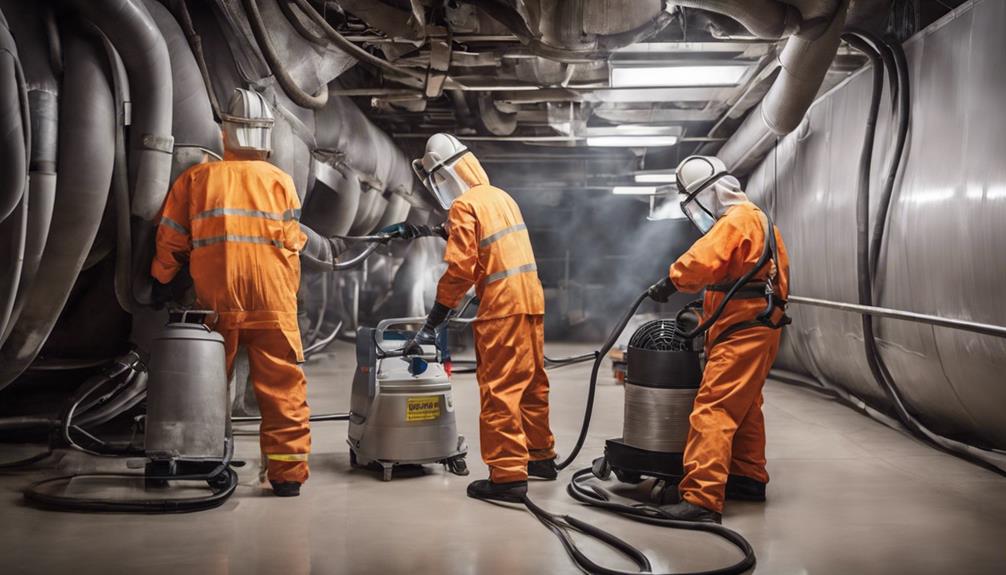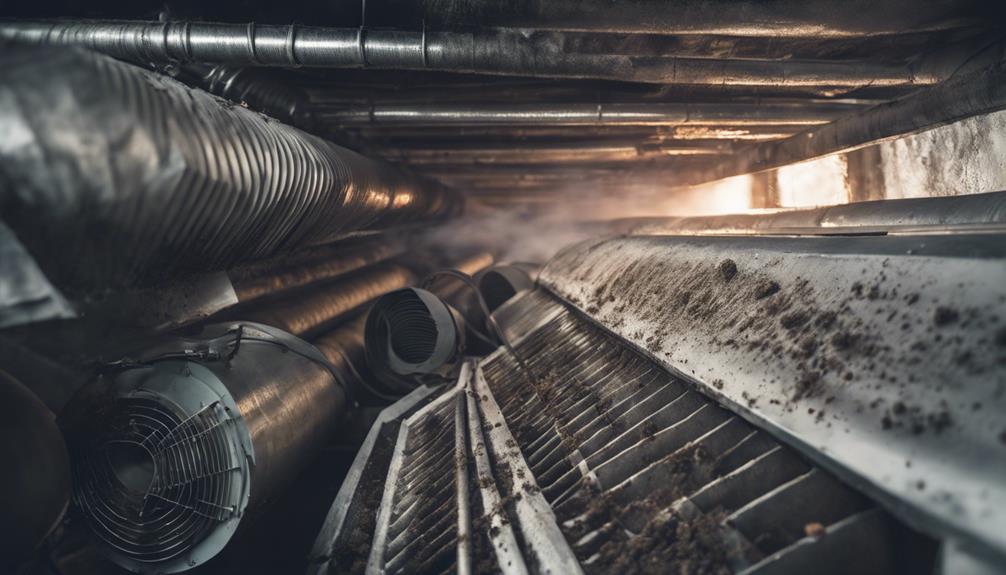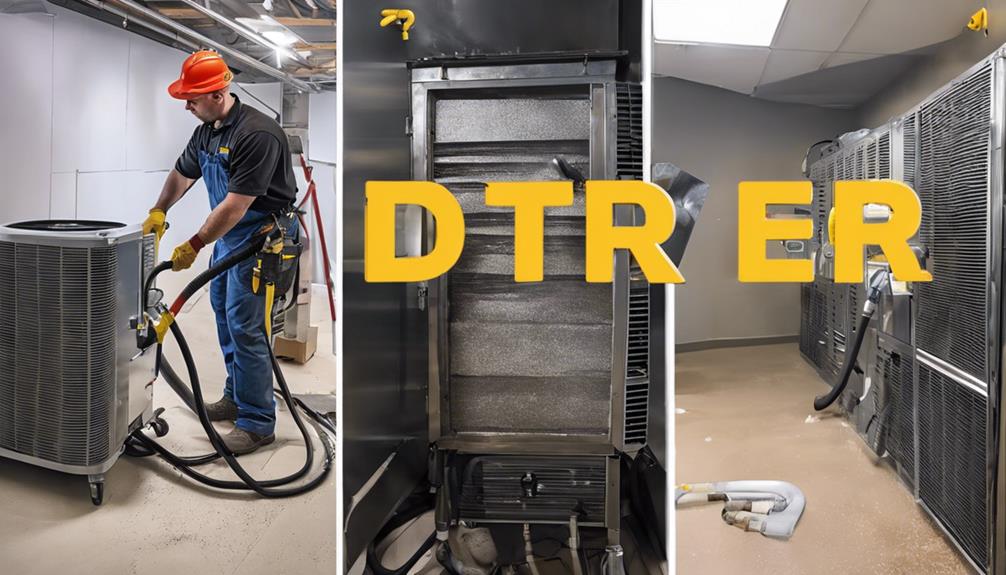When was the last time you pondered the state of your industrial air ducts? Over time, these hidden passageways accumulate more than just dust. The build-up within them can impact your facility in ways you might not expect. Take a moment to contemplate how clean air ducts could benefit your operations.
Importance of Airduct Cleaning

Regularly cleaning your airducts is crucial for maintaining good indoor air quality and guaranteeing peak performance of your HVAC system. Indoor air quality can greatly impact your health and overall well-being. Over time, airducts accumulate dust, debris, allergens, and even mold, which can be circulated throughout your home or office if not properly cleaned.
By investing in routine airduct cleaning, you can prevent these contaminants from polluting the air you breathe, reducing the risk of respiratory issues and allergies.
Moreover, the long term benefits of airduct cleaning are substantial. Clean airducts lead to improved energy efficiency, as a clean system doesn't have to work as hard to heat or cool your space. This efficiency translates to cost savings on your energy bills.
Additionally, by maintaining clean airducts, you prolong the lifespan of your HVAC system, saving you money on potential repairs or replacements in the future. Prioritizing airduct cleaning today ensures a healthier environment and financial savings in the long run.
Energy Efficiency Benefits
Maintaining clean airducts not only enhances indoor air quality but also boosts energy efficiency, leading to cost savings on your energy bills. When airducts are clogged with dust, debris, and pollutants, the HVAC system must work harder to circulate air throughout the building. This increased workload results in higher energy consumption, causing your energy bills to rise.
By ensuring your airducts are clean and clear, you can improve the airflow in your system, reducing the energy needed to heat or cool your space.
Enhanced indoor air quality from clean airducts also contributes to energy efficiency. When the air circulating through your ducts is clean, the HVAC system can operate more effectively, requiring less energy to maintain a comfortable temperature. Cleaner airducts mean your system doesn't have to work as hard to push air through, reducing overall energy consumption.
Health Impact of Clean Airducts

Improving indoor air quality through clean airducts can have significant health benefits for you and your family. When airducts are clean, the air circulating in your home is fresher and healthier, positively impacting your overall well-being.
Here are some key health benefits of clean airducts:
- Reduced Indoor Allergies: Clean airducts help eliminate dust, pollen, and other allergens that can trigger allergic reactions, providing relief for those prone to indoor allergies.
- Improved Respiratory Health: By removing contaminants like mold, bacteria, and pet dander from the airducts, clean airducts promote better respiratory health, reducing the risk of respiratory issues.
- Enhanced Well-being: Breathing clean air can boost your energy levels, improve sleep quality, and enhance your overall sense of well-being.
- Prevention of Health Issues: Regular airduct cleaning can help prevent health problems associated with poor indoor air quality, ensuring a healthier living environment for you and your family.
Cost Savings From Regular Cleaning
To further highlight the benefits of clean airducts, consider the cost savings that can result from regular cleaning. Investing in regular airduct cleaning not only guarantees a healthy environment but also proves to be cost-effective in the long run. By preventing the buildup of dust, debris, and contaminants within the ductwork, you can improve the efficiency of your HVAC system. A clean system operates more smoothly, leading to reduced energy consumption and lower utility bills.
Moreover, regular cleaning helps in extending the lifespan of your HVAC equipment. When airducts are clogged with dirt and pollutants, the system has to work harder to maintain the desired temperature, causing wear and tear. By maintaining clean airducts, you can avoid frequent repairs and premature replacements, resulting in significant long-term savings.
The initial investment in professional airduct cleaning services can pay off through improved cost effectiveness and long-term savings on energy bills and maintenance expenses. Prioritizing regular airduct cleaning is a smart financial decision that benefits both your budget and the overall efficiency of your industrial facility.
Common Airduct Contaminants

Various types of contaminants can accumulate in industrial airducts, impacting air quality and system efficiency. It's important to understand the common airduct contaminants that may pose health risks to individuals working in the vicinity.
- Dust: Dust particles are one of the most common contaminants found in airducts, which can trigger allergies and respiratory issues.
- Mold: Mold growth in airducts can release spores into the air, leading to respiratory problems and allergic reactions.
- Bacteria and Viruses: Harmful bacteria and viruses can thrive in airducts, potentially causing infections and illnesses among occupants.
- Chemical Fumes: Industrial airducts may carry chemical fumes from cleaning agents or manufacturing processes, which can be hazardous when inhaled.
Regular cleaning and maintenance of airducts are important to prevent the buildup of these contaminants and promote a healthier indoor environment. By addressing these common airduct contaminants, you can enhance air quality and mitigate potential health risks associated with contaminated airduct systems.
Tools for Effective Cleaning
Using the right tools is essential for effectively cleaning industrial airducts and maintaining a healthy indoor environment. When it comes to industrial airduct cleaning, having the appropriate cleaning equipment is vital for achieving the best air quality.
High-powered vacuums equipped with HEPA filters are necessary for removing dust, debris, and other contaminants from airducts effectively. These vacuums have the suction power needed to extract trapped particles, ensuring that the air circulating in the building is clean and free of pollutants.
In addition to powerful vacuums, specialized brushes and agitation tools are also required for dislodging stubborn dirt and grime from the walls of the airducts. These tools help to loosen buildup, making it easier for the vacuum to remove them completely.
DIY Vs. Professional Cleaning

Consider the benefits and drawbacks of tackling industrial airduct cleaning on your own versus hiring professional services. When deciding between DIY and professional cleaning, there are several factors to weigh.
- DIY pitfalls
- Lack of specialized equipment may lead to incomplete cleaning.
- Risk of damaging ductwork if proper techniques aren't followed.
- Time-consuming process, especially for large industrial systems.
- Limited knowledge on identifying and resolving potential issues within the ductwork.
- Professional advantages
- Expertise in using the latest tools and techniques for thorough cleaning.
- Ability to detect and address underlying problems like mold or pests.
- Efficiency in completing the job promptly with minimal disruption to operations.
- Compliance with industry standards and regulations for air quality.
When comparing costs and effectiveness, DIY cleaning may seem more budget-friendly upfront, but professional services often provide a more all-encompassing and long-lasting solution.
The effectiveness debate leans towards professional cleaning due to their expertise and ability to address hidden issues effectively.
Frequency of Cleaning
Determining how often industrial airduct cleaning should be performed is essential for maintaining high-quality air and system efficiency. Establishing a regular cleaning schedule is vital to guarantee peak performance and to adhere to best practices in the industry. The frequency of cleaning can greatly impact the environmental sustainability of your operations.
| Cleaning Schedule | Best Practices | Environmental Impact |
|---|---|---|
| Every 3-5 years | Hire professionals for thorough cleaning to remove accumulated debris and prevent mold growth. | Minimizes energy consumption and ensures clean air circulation, reducing the carbon footprint. |
| Annually | Conduct visual inspections periodically to check for dust buildup or microbial growth. | Preserves indoor air quality, reducing the risk of respiratory issues and improving overall employee health. |
| Bi-annually | Use high-efficiency air filters and consider investing in air purifiers for improved air quality. | Reduces the release of pollutants into the atmosphere, contributing to a greener environment. |
Maintaining a consistent cleaning frequency aligns with environmental responsibility while promoting a healthier work environment for all.
Signs Your Airducts Need Cleaning

Regularly checking for specific signs can help you determine when your air ducts need cleaning. Mold growth and allergy triggers can indicate that it's time to clean your air ducts.
Here are some signs to look out for:
- Visible Mold Growth: If you see mold growth inside the air ducts or around vents, it's a clear sign that cleaning is necessary.
- Increase in Allergy Symptoms: If you or your family members start experiencing more frequent allergy symptoms like sneezing, coughing, or congestion, dirty air ducts could be the culprit.
- Musty Odors: A musty or stale odor coming from the vents indicates the presence of mold, dust, or other contaminants in the air ducts.
- Visible Dust and Debris: If you notice an accumulation of dust, dirt, or debris around the vents or blowing out of them, it's a sign that the air ducts need cleaning.
Keeping an eye out for these signs can help you maintain clean and healthy air ducts in your industrial space.
Maintenance Tips for Clean Airducts
To maintain clean airducts in your industrial space, implementing regular maintenance tips is crucial to guaranteeing peak air quality and system efficiency. By following simple DIY techniques and utilizing the right equipment, you can keep your airducts in top condition. Here are some preventative maintenance strategies to help you achieve this:
| Maintenance Tips | Description |
|---|---|
| Regular Inspections | Conduct visual inspections of airducts for any signs of dust buildup or blockages. |
| Change Air Filters | Replace air filters regularly to prevent dirt and debris from circulating through the system. |
| Clean Vents and Registers | Vacuum and wipe down vents and registers to ensure proper airflow and prevent obstructions. |
| Use HEPA Vacuum | Utilize a HEPA vacuum to effectively remove dust and allergens from airduct surfaces. |
| Schedule Professional Cleaning | Arrange for periodic professional airduct cleaning to deep clean the system thoroughly. |
Conclusion
In summary, maintaining clean industrial airducts is essential for peak HVAC system performance, energy efficiency, and indoor air quality.
Regular cleaning not only saves costs but also promotes better respiratory health for occupants.
By addressing common contaminants and utilizing professional services when needed, you can secure a cleaner and healthier environment in your industrial facility.
Remember, a well-maintained airduct system is key to a productive and comfortable workplace.